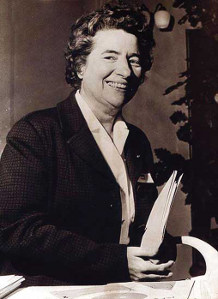Marguerite Perey
| Marguerite Perey | |
|---|---|
 |
|
| Born |
19 October 1909 Villemomble near Paris, France |
| Died | 13 May 1975 (aged 65) Louveciennes, France |
| Fields | Physics |
| Doctoral advisor | Marie Curie |
| Known for | Francium discovery |
| Notable awards | Leconte Prize (1960) |
Marguerite Catherine Perey (19 October 1909 – 13 May 1975) was a French physicist and a student of Marie Curie. In 1939, Perey discovered the element francium by purifying samples of lanthanum that contained actinium. In 1962, she was the first woman to be elected to the French Académie des Sciences, an honor denied to her mentor Curie. Perey died of cancer in 1975.
Perey was born in 1909 in Villemomble, France, just outside Paris where the Curie's Radium Institute was located. Although she hoped to study medicine, the death of her father left the family in financial difficulties. She interviewed for a job with Marie Curie at the age of 19, and was hired.
Perey spent a decade sifting out actinium from all the other components of uranium ore, which Curie then used in her study of the decay of the element. Although Curie died in 1934, the lab continued its study of actinium. A few years later Perey first noticed that the actinium she purified was emitting unexpected radiation. After further study she was able to isolate this new element which she named "francium" for France.
Following the discovery, she received a grant to finally pursue her university studies, and received a PhD from the Sorbonne in 1946. She was made the head of the department of nuclear chemistry at the University of Strasbourg in 1949 and continued her work on francium. She founded a laboratory that in 1958 became the Laboratory of Nuclear Chemistry in the Center for Nuclear Research, for which she served as director. Ironically she hoped that francium would help diagnose cancer, but in fact it itself was carcinogenic, and Perey developed bone cancer which eventually killed her.
Her archives with materials dating from 1929-1975 are held at the Université Louis Pasteur in Strasbourg. They include laboratory notebooks, course materials from her work as professor of nuclear chemistry, papers from her laboratory directorship, and publications.
...
Wikipedia
